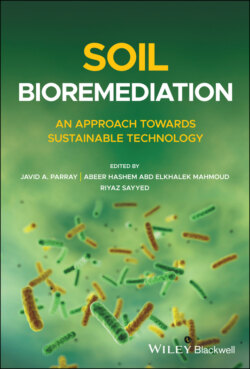Читать книгу Soil Bioremediation - Группа авторов - Страница 15
1.3.2 Biostimulation
ОглавлениеPetroleum hydrocarbons are degraded by native microorganisms, which are preferred by the nutrient presence in the polluted site [71]. The most significant source of native microbes is spilled hydrocarbons, whereas, N and P are limiting factors in almost all environments. Henceforth, biostimulation increases the rate of cleansing, as the potential of microbes is amended by the addition of one or more limiting factors or nutrients [72]. Environmental conditions, e.g., pH, and moisture content can also be improved to achieve optimum microbial degradation conditions [70]. Several researchers have studied the addition of N and P to enhance nutrient level. The biodegradation of petroleum hydrocarbons was enhanced by up to 96% after the addition of biosolids and N and P rich inorganic fertilizers to diesel contaminated soils [73]. Likewise, commercial fertilizers were used to remediate diesel oil in the Antarctic seas. Furthermore, higher concentrations of N and P sources can cause eutrophication, thereby enhancing algal growth and ultimately reducing the dissolved O2 concentration in the water [72]. Separate from nutrient content numerous other factors can greatly affect the degradation rate of polyaromatic hydrocarbons under natural environmental conditions, for example, physical mixing, use of biostimulation agents, mechanical tilling, manual removal, and C sources. It was observed that factors including the intensity of physical mixing, the pretreatments, and the accessibility of alternative carbon sources effected the degradation potential of microbes after Exxon Valdez oil spill [74]. Temperature has also a considerable effect on degradation potential of microbes, because it affects the viscosity, water solubility, and composition of oil. Furthermore, it also affects the metabolism of hydrocarbons and composition of microorganisms [70]. Subsequent to the spillage at Chedabucto Bay the effect of temperature on the degradation of bunker C fuel oil was studied, with temperature ranging from 5 to 28 °C, using mixed microbial cultures and it was found that 41–85% benzene soluble components disappeared after incubation of 7 days at 15 °C, however, 21–52% degradation was obtained after 14 days of incubation at 5 °C [75]. It was found that nutrient stock is essential for degradation by microorganisms under all environmental conditions. The degradation of the contaminant after 17 weeks was almost three times higher at 20 °C and eight times higher at 6 °C when compared to nutrient‐deficient sands [76]. On the other hand, temperature exhibited limited influence on petroleum degradation in Antarctic seawater samples in a laboratory microcosm study, where commercial fertilizer improved bioremediation [71]. Biostimulation aided with biosurfactants enhanced the rate of biodegradation [55, 77, 78]. Biostimulation using N and P fertilizer together with biosurfactants facilitated naturally occurring microbes to adapt better and faster to the oil spill contamination, confirming a relatively shorter lag phase and faster degradation rates [72]. The most promising strategy to enhance the rate of degradation is the use of a combination of biostimulation, bioaugmentation, and biosurfactants [79]. However, any such planned intervention must be followed by ecotoxicity and quality studies of the contaminated site to ascertain that it has regained its natural biological activity and integrity [58, 80]. Thus, toxicity tests and measuring microbial activity must be carried out for monitoring purposes during and after bioremediation of contaminated soils [81].
